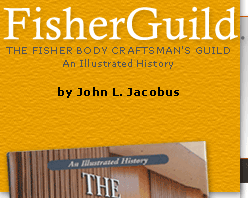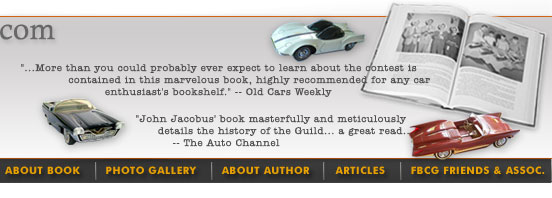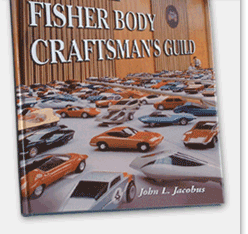|
T R A N S C R
I P T O F R
E V I E W
Fisher Body Craftsman’s Guild
Editor’s note: This is a condensed
version of notes from The Automotive Chronicles,
as a book review:
http://www.automotivechronicles.com/articles/2005/oct/02/index.php
The odds are that when you were a teenager
you were dreaming of owning a special car.
Not just an everyday mode of transportation,
but something different that projected your
personality. Buying popular magazines and
visiting auto dealerships and car shows,
you viewed the latest offerings and picked
up the sales brochures. Great as the new
cars were, the concepts or experimental
cars were better. Longer, lower and sleaker,
they were magic. They set your mind in motion
as to possibilities for the future.
Prior to the Chrysler Airflows and Cord
810/812, most makes differed little other
than grille shapes and chrome ornamentation.
Suddenly, in the mid-1930s, the influence
of aerodynamics was seized from the sleek
monoplanes and incorporated into the styling
of auto bodywork. The public was enthusiastic
and we were all style conscious. Boys were
sketching designs in their school notebooks
and at home they decorated their bedroom
walls with colorful drawings. Designs got
wilder in the 1950s with fins and lots of
chrome and sculpturing.
The Fisher Body Division of General Motors
began in 1930 to encourage teenagers to
compete for college scholarships by building
Napoleonic coach models. The coach was their
trademark and the contest concentrated on
following precise instructions
that tested the competitors' construction
skills. In 1937 the Fisher Body Guild contest
unlocked the dreams of potential designers
so they could display what they believed
future cars should look like.
In his book, The Fisher Body Craftsman's
Guild, John Jacobus quotes from the
placard in the Guild exhibit case at the
Smithsonian Institution, "From 1930
to 1968 millions of boys fascinated by cars
joined the Fisher Body Craftsman's Guild.
About
600,000 members enrolled each year in the
1950s making the Guild second in size only
to the Boy Scouts of America for young men."
John L. Jacobus previously worked as a Design
Engineer for the Fisher Body Division, General
Motors Corporation in Warren, Michigan.
John studied Industrial Design at the Art
Center College of Design in California and
at Wayne State University in Detroit. As
a youth,
he participated in the Craftsman's Guild
from 1961 to 1966. His hobby and passion
for the past 40 years has been automobiles,
automotive history and automotive
design history. During the past 20 years,
John has focused on auto stylists and designers
and the collecting of Fisher Body Craftsman's
Guild memorabilia. He was also instrumental
in a Craftsman's Guild exhibit and collection
at the Smithsonian Institution's National
Museum of American History.
Neither a textbook nor a dry history, The
Fisher Body Craftsman's Guild is more
like a collection of short stories. The
stories of the competitors draw your interest
and by the time the book is ended one wonders,
"Why did the competition end?"
Apparently
no one knows.
At www.FisherGuild.com
you will find a more comprehensive review
of the book's contents. In brief, if you
are interested in auto design, Guild history
or
model making, you will enjoy reading this
book. Even if you did not compete in the
Guild, or have never heard about the Guild,
as an automotive enthusiast the odds are
you will find this book fascinating.
To learn more about the history of Fisher
Body Divisions, GMC and the famous Fisher
Body Craftsman's Guild (1930-1968) public
relations program see:
http://www.geocities.com/sponcom26/index.html
|




